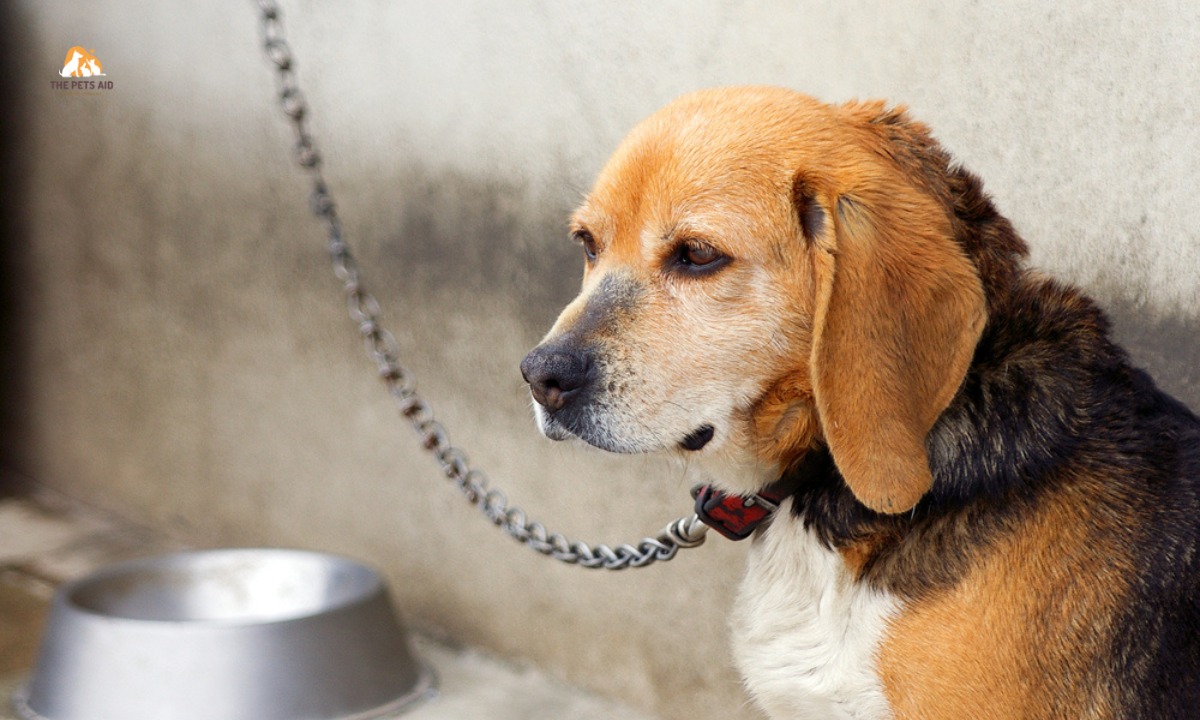Welcome to another informative piece here on ThePetsAid.com! Today, we delve into a topic that has been stirring up debates among pet owners and animal lovers: “Does chaining a dog make it aggressive?” Understanding the potential impacts of chaining on a dog’s temperament is crucial to ensuring our furry friends’ wellbeing.
As responsible pet owners, we strive to provide the best care and environment for our pets, but is the use of a chain conducive to a happy, non-aggressive dog? Join us as we unravel the facts and dispel this contentious issue’s myths.

Is it cruel to chain a dog?
Yes, it is cruel to chain a dog. This conclusion is supported by the consensus of experts in animal behavior and humane treatment, who agree that a solitary life at the end of a chain is inhumane for dogs. Dogs have been domesticated to form strong bonds with humans. Chaining them up can interfere with their natural need for social interaction, activity, and bonding, causing them significant stress and potential psychological harm.
Does chaining a dog make it aggressive?
Yes, chaining a dog or confining it intensely for long periods can lead to aggressive behavior. This is due to the fact that such conditions can seriously harm the dog’s bodily and psychological wellbeing, causing it to become neurotic, sad, worried, and frequently violent.
This is even the case for dogs that are typically friendly and docile. Thus, it’s important to provide dogs with sufficient space to move and exercise and regular social interaction to maintain their mental and physical health.
How long can a dog be on a chain?

Based on SB 1578, also known as the tethering law, a dog cannot be chained, tethered, fastened, tied, or restrained to a doghouse, tree, fence, or any other stationary object for more than three hours in a 24-hour period.
Do dogs like to be on a chain?
It can be inferred that dogs dislike being on a chain. The confinement and isolation caused by being continually tethered can lead to negative behavioral changes such as neurosis, unhappiness, anxiety, and increased aggression.
Being social pack animals, dogs prefer to have the freedom to move and interact without being restricted by a chain.
Why do dogs bark when chained?
Dogs typically bark when chained due to feelings of frustration. When a dog is restrained, it can’t engage in its natural behaviors, such as playing, exploring, or interacting freely with other dogs and humans. This inability to participate in normal activities can lead to a feeling of frustration, which dogs often express through barking.
Barking is a form of communication for dogs, and bark can mean many things, including a call for attention, a response to anxiety or stress, or an expression of boredom. In the context of being chained, it’s likely the dog is feeling confined and unable to satisfy its natural instincts, leading to frustration that is expressed through barking.
It’s important to note that prolonged chaining can lead to behavioral issues and it’s generally not a recommended way to manage dogs. Dogs require exercise, mental stimulation, and social interaction to live healthy and happy lives.
How do you make a chained dog happy?
Here’s how you can make a chained dog happy:
- Take your dog inside: Dogs are sociable creatures who want companionship and stimulation. Leaving a dog chained outside all day might result in behavioral issues and despair. Bring the dog inside as much as possible, especially during inclement weather. They can benefit from the warmth in winter and air conditioning in summer, and it also gives them a chance to be part of the family activities, which is crucial for their mental health.
- Replace old collars with a new nylon collar: Old, worn-out collars can be uncomfortable and even harmful to dogs. Replacing it with a new, soft nylon collar can significantly improve the dog’s comfort.
- Food and fresh water daily: Like all living beings, dogs need to eat and drink to stay healthy. Make sure they have access to fresh, clean water at all times, and feed them a balanced diet suitable for their breed, age, and health status.
- Provide good shelter: If the dog must spend some time outside, make sure they have a suitable shelter to protect them from the elements. The shelter should be dry, clean, and large enough for the dog to wander about comfortably. It should also provide shade in the heat.
- Protect from fleas and worms: Regular vet check-ups and preventative treatments can keep your dog safe from parasites like fleas and worms, making them uncomfortable and potentially leading to serious health problems.
- Protect from winter cold: If the dog can’t be brought inside during winter, take steps to ensure they stay warm. This can include providing an insulated dog house, a heated bed, and even doggy clothes.
Remember, while these steps can improve the life of a chained dog, the best option is to avoid chaining dogs whenever possible. Regular exercise, training, socialization, and affection are critical to a dog’s wellbeing and can’t be fully provided if a dog is perpetually chained.
Can I walk my dog with a chain?

Walking your dog with a chain is highly discouraged. The use of a chain can lead to injuries and negatively affect your dog’s mental and physical health. If your dog were to become tangled in the chain, it could lead to severe situations such as asphyxiation or death.
Instead, it would be much safer and more humane to use a standard leash or harness designed for dogs when taking them for walks. These are designed to be comfortable for the dog while also giving the handler good control.
Can I tie my dog up at night?
It is not recommended to tie up your dog at night. There are several reasons for this:
- The dog may need to move around to access water or relieve itself. Tying up could make it distressed or uncomfortable if it cannot meet these basic needs.
- Dogs often serve as guards for homes, and if tied up, they may need help to perform this role adequately. They need freedom to explore their surroundings and ensure the safety of the household.
Remember, it’s essential to consider your pet’s wellbeing and comfort. The dog’s ability to move freely, especially when the household is asleep, can contribute to its overall health and happiness.
How tight should a dog chain be?
A dog chain should be snug, but not tight. The general rule is that you should be able to fit two fingers under your dog’s collar. However, if your dog is very small, you should only be able to fit a single finger; for very big dogs, it should be three fingers.
At what age can you chain a dog?
A dog can be tethered or chained outside starting from the age of 6 months. However, the tether or chain used should be designed for dogs, and its weight should not exceed 1/8 of the dog’s body weight. Logging chains or other devices not designed for tethering dogs should not be used.
How long should I chain my dog?
The length of the chain should be long enough for the dog to move around comfortably, sit in shade, reach its food and water bowls, and other necessary activities. That said, it’s important to note that chaining a dog should only be a temporary measure and not a long-term living situation.
The exact length would depend on the size of your dog and the area available but should be as long as feasibly possible to give the dog the maximum amount of movement space. However, it’s critical to ensure the chain is shorter that the dog could get tangled up or reach dangerous areas.
Remember to take your dog for walks regularly and allow it off the chain as much as possible, ideally more than once a day. Dogs require regular exercise and social interaction to be happy and healthy, which can’t be fulfilled if they’re constantly chained up. Always ensure the dog’s safety and wellbeing while tethered.
Please be aware that in some jurisdictions, it may be illegal to chain or tether dogs for extended periods, so it’s also important to check your local laws and regulations regarding this issue.
What is chain behavior for dogs?
A chain behavior for dogs is a series of behaviors linked together, with each action in the chain serving as both the cue for the next behavior and the reward for the previous one. Each action is a link in the chain, and the overall behavior chain is completed when the final action is performed and the final reward is given.
In the example you provided, the behavior chain for “fetch it” could be broken down as follows:
- You give the command “fetch it” and point to the item.
- The dog goes to the item (rewarded by the opportunity to perform the next action).
- The dog picks up the item in his mouth (rewarded by the opportunity to perform the next action).
- The dog turns around (rewarded by the opportunity to perform the next action).
- The dog returns to you (rewarded by the opportunity to perform the next action).
- The dog places the item in your hand (rewarded by the opportunity to receive praise and a treat).
- You give praise and a treat as the final reward.
For the chain to be properly completed, each step is crucial and must be carried out in the right order. The chain is broken and the desired outcome is not obtained if a step is skipped or carried out improperly. As a result, teaching a dog to follow a behavior chain takes time and effort, with each step needing to be rewarded before the next.
Conclusion
Thank you for taking the time to read and learn with us. Keep an eye out for more in-depth discussions on pet-related topics here at ThePetsAid.com. Remember, our pets depend on us to make the best decisions for them. Here’s to happier, healthier pets everywhere!
